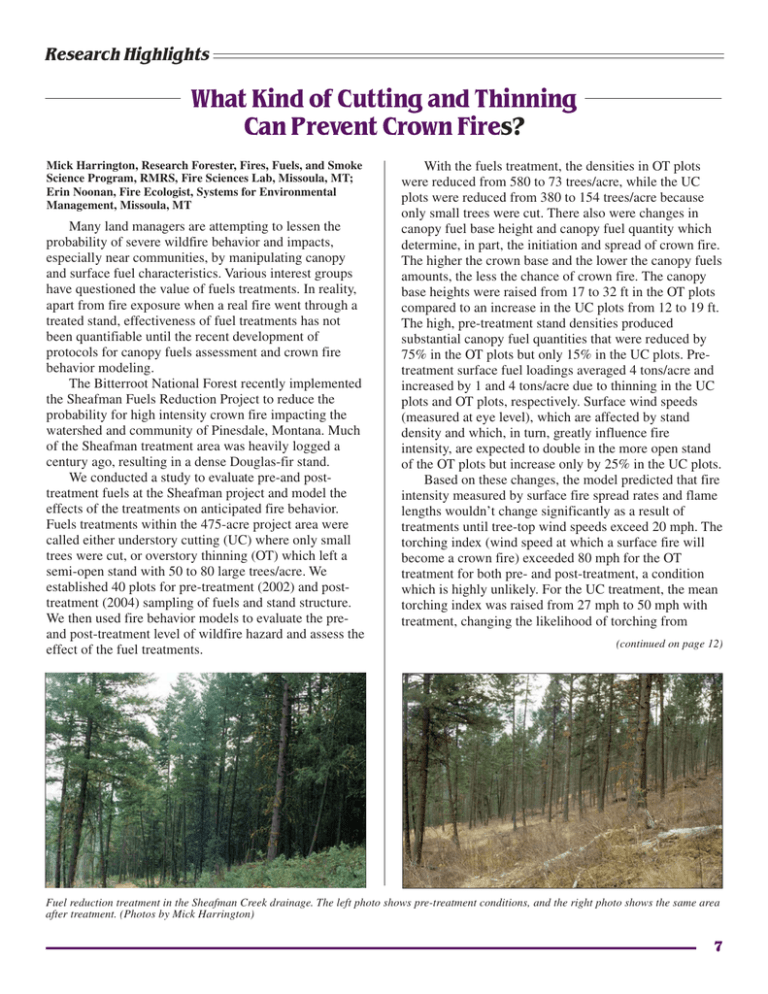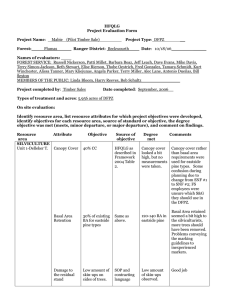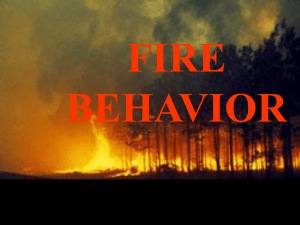What Kind of Cutting and Thinning Can Prevent Crown Fire s? Research Highlights
advertisement

Research Highlights What Kind of Cutting and Thinning Can Prevent Crown Fires? Mick Harrington, Research Forester, Fires, Fuels, and Smoke Science Program, RMRS, Fire Sciences Lab, Missoula, MT; Erin Noonan, Fire Ecologist, Systems for Environmental Management, Missoula, MT Many land managers are attempting to lessen the probability of severe wildfire behavior and impacts, especially near communities, by manipulating canopy and surface fuel characteristics. Various interest groups have questioned the value of fuels treatments. In reality, apart from fire exposure when a real fire went through a treated stand, effectiveness of fuel treatments has not been quantifiable until the recent development of protocols for canopy fuels assessment and crown fire behavior modeling. The Bitterroot National Forest recently implemented the Sheafman Fuels Reduction Project to reduce the probability for high intensity crown fire impacting the watershed and community of Pinesdale, Montana. Much of the Sheafman treatment area was heavily logged a century ago, resulting in a dense Douglas-fir stand. We conducted a study to evaluate pre-and posttreatment fuels at the Sheafman project and model the effects of the treatments on anticipated fire behavior. Fuels treatments within the 475-acre project area were called either understory cutting (UC) where only small trees were cut, or overstory thinning (OT) which left a semi-open stand with 50 to 80 large trees/acre. We established 40 plots for pre-treatment (2002) and posttreatment (2004) sampling of fuels and stand structure. We then used fire behavior models to evaluate the preand post-treatment level of wildfire hazard and assess the effect of the fuel treatments. With the fuels treatment, the densities in OT plots were reduced from 580 to 73 trees/acre, while the UC plots were reduced from 380 to 154 trees/acre because only small trees were cut. There also were changes in canopy fuel base height and canopy fuel quantity which determine, in part, the initiation and spread of crown fire. The higher the crown base and the lower the canopy fuels amounts, the less the chance of crown fire. The canopy base heights were raised from 17 to 32 ft in the OT plots compared to an increase in the UC plots from 12 to 19 ft. The high, pre-treatment stand densities produced substantial canopy fuel quantities that were reduced by 75% in the OT plots but only 15% in the UC plots. Pretreatment surface fuel loadings averaged 4 tons/acre and increased by 1 and 4 tons/acre due to thinning in the UC plots and OT plots, respectively. Surface wind speeds (measured at eye level), which are affected by stand density and which, in turn, greatly influence fire intensity, are expected to double in the more open stand of the OT plots but increase only by 25% in the UC plots. Based on these changes, the model predicted that fire intensity measured by surface fire spread rates and flame lengths wouldn’t change significantly as a result of treatments until tree-top wind speeds exceed 20 mph. The torching index (wind speed at which a surface fire will become a crown fire) exceeded 80 mph for the OT treatment for both pre- and post-treatment, a condition which is highly unlikely. For the UC treatment, the mean torching index was raised from 27 mph to 50 mph with treatment, changing the likelihood of torching from (continued on page 12) Fuel reduction treatment in the Sheafman Creek drainage. The left photo shows pre-treatment conditions, and the right photo shows the same area after treatment. (Photos by Mick Harrington) 7 Research Highlights Mapping Cultural Values . . . (from page 4) Mice . . . (from page 8) On the Reservation, we found that the primary meanings Tribal members associate with the Buffer Zone are wilderness protection, wildlife and water quality, access and functional attachments (such as a source of medicinal plants), recreation and scenic values, and personal and cultural meanings symbolic of long-term associations with nature in the Northern Rockies. We used a computer-based mapping exercise to develop 154 community resident maps of important places in the Buffer Zone across these five types of meanings. The map on the bottom of page 4 represents an overall average of those maps. We also asked study subjects to identify major threats they perceive to these meanings. Initial analysis reveals that residents perceived four primary categories of threats to the meanings they attached to the Buffer Zone: wildfire, intense logging, roads and development, and off-highway vehicle use. The threat of wildfire was broadly recognized by many subjects and blamed on years of fire restriction, resulting in the feeling that now uncontrolled fires would be disastrous due to overstocked or dense vegetation. Logging also was commonly listed among threats, giving rise to the dilemma that Tribal resource managers face. Specifically, people expressed fears about intense logging, extreme logging, commercial logging, and large scale logging, suggesting that people are more threatened by the scale and intensity it might entail than the logging itself. Residents are also concerned about other threats to the Buffer Zone such as perceived increases in road access, subdivision of property, and ATV and motorcycle use on and off roads. Some miscellaneous threats attached to specific areas in the Buffer Zone were cattle grazing, recreation over use, horses, litter, weeds, impacts to water quality, and insect outbreaks. While many of these threats exist at a large scale, many were attached to specific places in the Buffer Zone, providing opportunity to base discussions with the public about priorities for future management actions. BEMRP scientists will continue to facilitate interaction between forest managers and the public as proposals are developed in 2008 to reduce fire hazard, increase forest health, and restore the natural role of fire on Tribal lands. following natural wildfire, evaluated deer mouse seed predation on Douglas-fir and ponderosa pine seeds, and determined whether seed predation affected tree regeneration. At two different sets of study sites on the Lolo National Forest, we confirmed that deer mouse populations increase dramatically in the first years after forest fires. At one set of study sites, we put out ponderosa pine and Douglas-fir seeds in trays to evaluate deer mouse seed selection. We also placed seeds on the ground in cages that either allowed or precluded mouse access to evaluate the effect of seed predation on seedling recruitment. Our preliminary data indicate that 1) mice did not exhibit size-dependent seed selection, i.e., mice consumed Douglas-fir seeds as readily as ponderosa pine seeds, 2) mice consumed large numbers of both seed species, and 3) seed predation by mice greatly reduced recruitment of seedlings for both species. Thus, mice may influence the rate of post-fire regeneration, but not the trajectory, meaning the direction the system is going such as toward a forest dominated by one tree species over another. When finished, our study will improve our understanding of animal-plant interactions in western forest succession and determine whether deer mice warrant special management in regenerating forests. 12 What Kind of Cutting . . . (from page 7) possible to improbable. The crowning index (wind speed at which fire will spread in the tree crowns) almost tripled in the OT plots from 12 to 34 mph with thinning but changed minimally (17 to 19 mph) in the UC treatment. This contrast reflects the large and small canopy fuels changes for the OT and UC plots, respectively. Therefore, models show that surface wind speeds increase as a result of thinning, which in turn leads to an increase in surface fire intensity. However, this expected fire intensity increase should not result in increased crown fire potential. Instead, reductions in canopy fuel quantities and increases in canopy base heights in the OT treatment results in a low probability of crown fire spreading or even initiating. Increases in canopy base heights with removal of ladder fuels in the UC treatment greatly reduce the chance of crown fire initiation. But with the overstory fuels virtually unaltered, the likelihood of crown fire spread remains unchanged. So, the trade-off for increased fire intensity is a substantial decrease in crown fire potential.




